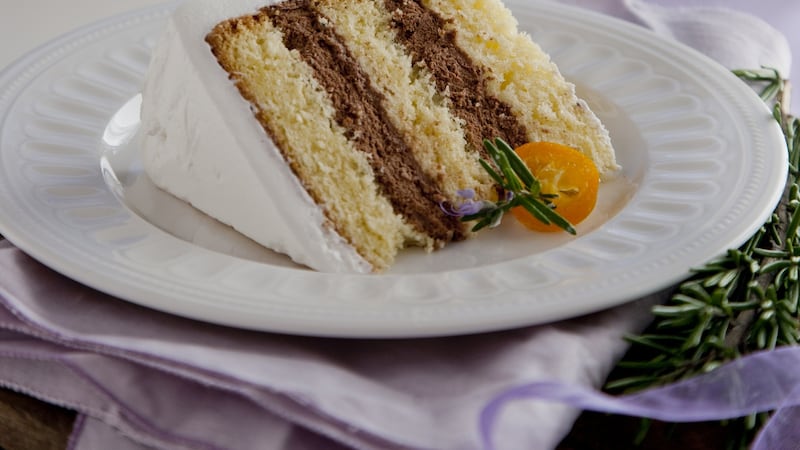Ingredients
- Cake for the top tier:
- 50g butter
- 4 large eggs
- 130g caster sugar
- 130g plain flour
- Cake for middle tier:
- 125g butter
- 8 large eggs
- 250g caster sugar
- 250g plain flour</li><li/><li>Cake for the bottom tier:
- 175g butter
- 12 large eggs
- 380g caster sugar
- 380g plain flour
- Chocolate mousse to fill the top tier:
- 10g gelatine (powdered)
- 100ml cream
- 150g dark chocolate, minimum 55% cocoa solids
- 10ml brandy
- 2 large eggs</li><li/><li>Chocolate mousse to fill middle tier:
- 20g gelatine (powdered)
- 284ml cream
- 275g dark chocolate
- 15ml brandy
- 4 large eggs
- Chocolate mousse to fill bottom tier:
- 40g gelatine (powdered)
- 568ml cream
- 550g dark chocolate
- 30ml brandy
- 8 large eggs</li><li/><li>For the Swiss meringue:
- 20 egg whites
- 1.3kg granulated sugar
- 1.3kg butter, softened but cool
- 3 tsp vanilla extract, or the seeds of three vanilla pods. Vanilla bean looks and tastes better but for a cleaner look use extract
You’ll be mixing the batter for the three cake layers separately, and baking them for different lengths of time, to account for the differing cake tin sizes you’ll be using.
You will need one 15cm/6in tin, one 23cm/9in tin and one 30.5cm/12in tin. The smallest cake bakes for 35-40 minutes, the middle tier for 40-45 minutes and the largest for about 75 minutes. In each case the oven temperature is 180 degrees.
METHOD FOR THE CAKE: Melt the butter over a gentle heat, set it aside. Line the base and sides of the tin with greaseproof paper. Whisk the eggs until foamy, then gradually add the sugar. Whisk for about 20 minutes, or until very thick and pale and you reach the "ribbon stage" – when the whisk leaves a ribbon-like trail.

Sift half the flour over the egg mixture. Fold in gently with a metal spoon. Repeat with the remaining flour, and fold in until there are no flour pockets left. Spoon the melted butter around the edge of the mixture and gently fold it in with three or four very light movements of the spoon. Be gentle with the mixture – the aim is to retain as much air in the eggs as possible.
Pour the mixture into the cake tin. Bake at 180°C for the required length of time. When cooked, the cake should be well risen, firm to the touch in the centre and just pulling away from the edges of the tin. Leave in the tin for five to 10 minutes.
Loosen the sides of the cake and turn it out onto a paper-lined cooling rack. Leave it to cool upside down to give a flat top. When the sponge is cold, wrap it and store it for up to two days.
METHOD FOR THE MOUSSE: You will also be making the dark chocolate mousse in three batches. The first step in the method for all three is the same, but the quantities differ. For the top tier, sprinkle the gelatine over 30ml cold water in a heatproof bowl and set it aside. Put the broken chocolate in a heatproof bowl with 50ml cold water. For the middle batch of mousse, sprinkle the gelatine over 60ml cold water and put the chocolate in a heatproof bowl with 100ml cold water. For the largest batch, use 150ml cold water for the gelatine and 200ml cold water for the chocolate.
The next step, in each case, is the same. Whip the cream until it stands in soft peaks, then chill it. Put the chocolate with the cold water over a pan of simmering water and stir until melted. Remove the chocolate from the heat and stir in the brandy and egg yolks, reserving the egg whites. Cool the mixture, and then fold in the whipped cream.
Melt the gelatine over a pan of simmering water until it is clear. Allow it to cool a little, then stir this into the chocolate. Chill until lightly set; about 15 minutes.
Whisk the egg whites until stiff, and then fold them carefully into the chilled chocolate mixture. Chill the mousse in the fridge for about 30-40 minutes.
TO SANDWICH THE CAKES: Carefully cut each cake horizontally into three, using a long-bladed, serrated knife. Use a flat baking sheet to lift and support the layers when sandwiching them.
Lightly oil the original cake tin and line the base and the sides with greaseproof paper, making a collar to stand 7.5cm (3in) above the tin.
Place one cake layer in the base of the tin, cut side uppermost. Spread with half the mousse. Place the second layer of cake on the mousse; gently press down. Spread the remaining mousse over the top and cover with the third piece of cake, cut side down. Cover with clingfilm and chill overnight. Remove the sandwiched cake from the tin, wrap it up and it can now be frozen, if you wish. Repeat the process for the other cakes.
TO POSITION THE CAKE: Make sure all your cakes (except the bottom one, which should be sitting on a heavy duty cake board or drum at least two to four inches bigger than the cake), are sitting on thin cake boards the same size as the cake.
Cut four pieces of dowelling 2cm longer than the depth of the bottom tier and four pieces 2cm longer than the depth of the middle tier. Insert four pieces of dowelling around the middle of the bottom tier. The circle should be slightly smaller than the middle tier cake base. Gently hold the middle tier above the bottom tier to ensure that it is level, and then set it aside. Repeat the same procedure with the dowelling for the middle tier. Keep the cakes in the fridge until needed.
METHOD FOR SWISS MERINGUE: You'll be making this in one batch. Place the egg whites and sugar in a large metal or glass bowl. Set the bowl over a pot of simmering water, and whisk, continuously, until the sugar has dissolved and the mixture looks opaque. Remove the bowl from the heat, add the vanilla extract, and whip on high speed until it is completely cool. Whip in the butter, a tablespoon at a time, until thick and fluffy. If it begins to look curdled, whip until it comes back together, before adding the remaining butter. If the egg whites and/or butter are slightly too warm, it may not thicken. This can be remedied by placing it in the fridge for 20-30 minutes, then whipping again.
TO DECORATE: Position the bottom tier on the cake board. Using a palate knife, spread half the icing over the top and sides of the cake. Place the next two layers on their cake boards and repeat. Put the cakes in the fridge and allow the icing to set.











